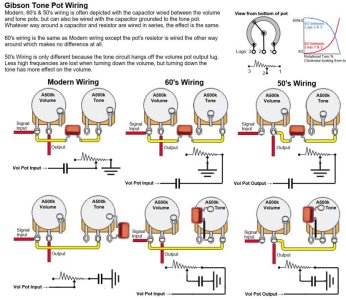You are using an out of date browser. It may not display this or other websites correctly.
You should upgrade or use an alternative browser.
You should upgrade or use an alternative browser.
Is there a benefit to putting a treble bleed on a guitar that have a tone control?
- Thread starter BadAspen
- Start date
Do you notice an issue when turning down the volume?
No, I'm taking a few classes in circuits and want to know a little more about some of the real world circuits I regularly use.
If a single volume control does still cut highs as you cut volume, then it makes no sense to me that pickup->tone->volume (modern wiring) cuts highs and pickup->volume->tone (50s wiring) doesn't cut highs, but pickup->volume->output does.
beaubrummels
Well-known member
No, I'm taking a few classes in circuits and want to know a little more about some of the real world circuits I regularly use.
If a single volume control does still cut highs as you cut volume, then it makes no sense to me that pickup->tone->volume (modern wiring) cuts highs and pickup->volume->tone (50s wiring) doesn't cut highs, but pickup->volume->output does.
You're 'diagram' is overly simplistic. The tone control is not in between the pickup and the volume, nor in between the volume and the output. The tone is tapped off different locations in the circuit and goes to ground independently of the volume. Where it's tapped off the circuit affects the load the pickup sees. Also, not only does 50s wiring affect the treble of the signal, it also affects how the tone and volume interact.
Yeah, but there is extensive limitations on brief circuits in a textbox. What is the difference between these three circuits such that 50s wiring doesn't experience the treble loss that the other two do? I mean outside of the inherent treble loss of grounding a high impedance signal.
beaubrummels
Well-known member
Yeah, but there is extensive limitations on brief circuits in a textbox. What is the difference between these three circuits such that 50s wiring doesn't experience the treble loss that the other two do? I mean outside of the inherent treble loss of grounding a high impedance signal.
In 'modern' wiring, the tone is tapped off the volume input, essentially off the pickup directly, so some treble leaks to ground through the tone pot before going through the volume pot. In 50's wiring, because the tone is tapped off the output of the volume pot, the amount of treble leaked to ground through the tone pot is governed by the volume pot. Volume alone, the effect is more severe with a lower resistance pot. If you don't want to use a treble bleed, using a higher value pot can help keep the guitar brighter. Treble bleeds do what they say, as you turn down, treble continues to leak to the output, making it seem brighter as you turn down. If the treble bleed has too strong of an effect, instead of turning the volume down, it can sound like a bass cut instead. That's why it takes playing with the recipe to find the right cap/resistor combination that sounds natural to your ear.
marcello252
Well-known member
In 'modern' wiring, the tone is tapped off the volume input, essentially off the pickup directly, so some treble leaks to ground through the tone pot before going through the volume pot. In 50's wiring, because the tone is tapped off the output of the volume pot, the amount of treble leaked to ground through the tone pot is governed by the volume pot. Volume alone, the effect is more severe with a lower resistance pot. If you don't want to use a treble bleed, using a higher value pot can help keep the guitar brighter. Treble bleeds do what they say, as you turn down, treble continues to leak to the output, making it seem brighter as you turn down. If the treble bleed has too strong of an effect, instead of turning the volume down, it can sound like a bass cut instead. That's why it takes playing with the recipe to find the right cap/resistor combination that sounds natural to your ear.
^ this, in 50's wiring you apply the same low pass filter (the tone control) in parallel with a different Resistor value (the one obtained by the res partitor of the Volume) , so its behaviour different, the highpass filter (the treble bleed circuit) is always applied on the same part of the volume knob.
There's a lot of confusion about so called 50's wiring. It's a Gibson thing (not all guitar makers wire things the same way) and it mainy concerns whwre the tone circuit connects to the volume pot as has already been stated. I put together a diagram about this to try and get it straight in my own head.
Last edited:
eclecticsynergy
New member
No, I'm taking a few classes in circuits and want to know a little more about some of the real world circuits I regularly use.
If a single volume control does still cut highs as you cut volume, then it makes no sense to me that pickup->tone->volume (modern wiring) cuts highs and pickup->volume->tone (50s wiring) doesn't cut highs, but pickup->volume->output does.
With 50s wiring you lose less highs than modern wiring, but there still is some treble loss through the tone pot.
As pointed out, the tone pot is not really in the signal path, it just taps some high end off, through a cap to ground.

